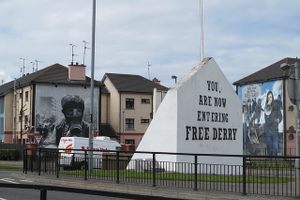About
In the Bogside neighborhood of Northern Ireland is a small, yet poignant museum dedicated to preserving the memory of the civil rights movement of Northern Ireland.
The museum was founded in 2007 by members of the Bloody Sunday Trust. It was created to chronicle the history of the Bloody Sunday massacre and the civil rights movement in Derry. On display are well over 25,000 artifacts, mostly donated by Derry locals.
In 1972, a civil rights march was organized by activist and politician Ivan Cooper. More than 15,000 people marched through the streets of Derry in nonviolent protest. The march drew inspiration from the civil rights marches that took place across the southern United States.
The civil rights movement in Derry emerged in response to several factors, such as entrenched political corruption and consistent police brutality. It also raised awareness to several other issues plaguing those living in Northern Ireland.
The 1972 march eventually encountered British military barricades. This led to some youths, not attached to the protest, to hurl stones at the military. Eventually, this conflict led to the soldiers firing live rounds into the crowd, killing 14 civilians. During a later inquiry into the massacre, soldiers claimed they were being attacked by Provisional Irish Republican Army terrorists, however, no credible evidence supported those claims.
The most moving display inside the museum is undoubtedly the civil rights banners and placards that were carried by nonviolent protestors, many of whom were killed during Bloody Sunday. Inside, you can also see other paraphernalia such as rubber bullets, CS canisters, and real bullets fired by the British military.
Related Tags
Know Before You Go
The Museum of Free Derry is open Monday to Friday 9:30 a.m. to 4:30 p.m. and on weekends from 12 p.m. to 4 p.m. Entry costs £6. It's easy to find as it is located close to the Free Derry Corner murals.
Published
September 25, 2019
Updated
September 18, 2024






















